OG-107
The OG-107 was the basic work utility uniform (fatigues) of all branches of the United States Armed Forces from 1952 until its discontinuation in 1989. The designation came from the U.S. Army's coloring code "Olive Green 107", which was the shade of dark green used on the original cotton version of the uniform. The OG-107 was superseded by the Battle Dress Uniform (BDU) throughout the 1980s, and was also used by several other countries, including ones that received military aid from the United States.
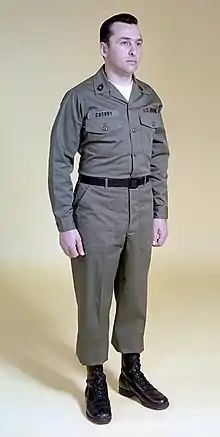
All versions of the OG-107 shared several basic design features. They were made out of an 8.5 ounce cotton sateen. The shirt could be tucked in or worn outside the trousers depending on the preference of the local commander. If sufficiently hot and humid, troops could be permitted to roll up the sleeves and unblouse the trousers. It consisted of a button front and two simple patch pockets on the upper chest that closed by means of a buttoned flap. The trousers were straight leg pants intended to be bloused (tucked in) into boot tops with two simple patch pockets in the front with slash openings and two simple patch pockets on the back with a button flap.
History
The OG-107 uniform was introduced in 1952 during the Korean War, succeeding the M1943 Uniform. It became the standard for use both in the United States and on overseas deployment by the beginning of the Vietnam War. As the Tropical Combat Uniform (jungle fatigues) became more plentiful in South Vietnam, they began to replace the OG-107 uniform in combat units.
In the United States and foreign postings (outside of Southeast Asia), the OG-107 remained the standard uniform throughout the 1960s and 1970s. This is one of the longest issued uniforms by the US Military, seeing use from 1952 until the adoption of the woodland-patterned camouflage Battle Dress Uniform (BDU) as the armed-forces-wide replacement beginning in 1981 and being completed by 1989. Minor modifications were made to the uniform over time such as adding buttoned cuff slits in the mid-1960s.
Basic designs
There were three basic models or "patterns" for the OG-107 Cotton Sateen Utility Uniform:
"Type I" (1952–1963)
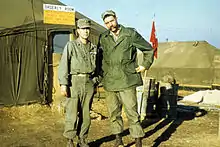
The first "Type I" model was introduced in 1952 and remained virtually unchanged through its 10-year production run. The shirt featured a sleeve with no true cuff or buttons; it was simply a straight sleeve with a simple hem at the cuff. The shirt's two chest pockets and the trousers rear two pockets had a rectangular pocket flap that buttoned. The buttons were a "dished" style and most of the 1950s production were a dark brown color while the majority of the 1960s production were dark green. The trousers also had a simple adjustment tab on the waist that could be buttoned. The shirt and trousers were also sized in groups (Small, Medium, Large, etc.) This model was replaced in April 1963 when specifications came out for the second model.
"Type II" (1963–1964)

The "Type II" was specified for production in April 1963 and had several slight variations from the Type I. The only change of any real significance was the "clipping" of the pocket flaps on the shirt, so that they no longer appeared rectangular. As with the Type I, the shirt and trousers were also sized in groups. Due to the limited production time before the Type III was specified, these were not seen nearly as often as the Type I or III.
"Type III" (1964–1989)
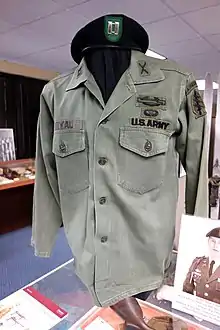
The "Type III" is the most common model and can be split into two versions based on the time of manufacture and material.
- Cotton – This version was specified at the very end of 1964 and still used the standard 8.5 ounce cotton sateen. However, due to changes in production and distribution time, they were not really seen until 1966. This version maintained all of the key distinctive style features such as the pockets, but with some key differences. The two shirt chest pockets received a pointed pocket flap. The shirt also received a button cuff at the wrist. The buttons were changed to the "standard" dull plastic button as used on jungle fatigues (and later BDUs). Another change to the trousers was the removal of the waist adjustment tab. Both the shirt and pants also adopted the "true measurement" sizing style – for example, pants were marked in waist and inseam length (32" x 34" would show pants with a 32" waist and 34" inseam) and the shirts were marked in neck size and sleeve length (16.5" x 34" would show a shirt with a 16.5" neck and a 34" sleeve length).
- Poly Cotton blend – A second version came into use in 1975 and was in production until 1989, when it was fully replaced by the woodland BDU. This model switched from using 100% cotton to a 50/50 blend of polyester and cotton. The difference in fiber material necessitated a modified color code, OG-507, but the two colors appeared identical. The poly-cotton uniforms were often referred to as "permanent press" as they did not require extensive starching. They could be quickly identified by a yellow tag in the garment.
Jungle fatigues

US Army Tropical Combat Uniform, commonly called "jungle fatigues", were issued to troops fighting in the Vietnam War beginning in 1964. They initially used the same OG-107 color as the standard utility uniform, but were of a different design and construction. Made out of lighter weight cotton poplin, they consisted of trousers with cargo pockets on each leg and a bush jacket-style top with slanted chest pockets and two lower pockets. The uniforms were revised multiple times during the war in response to issues with the design, and later in the war, versions using ERDL pattern camouflage were issued to special forces and Marines.[1]
Users

.svg.png.webp) Brazil
Brazil.svg.png.webp) Bolivia
Bolivia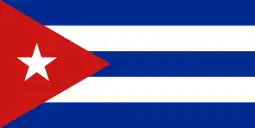 Cuba – After the Cuban Revolution, the FAR continued wearing the same uniforms.
Cuba – After the Cuban Revolution, the FAR continued wearing the same uniforms. Egypt
Egypt Hungary – Wears a copy.
Hungary – Wears a copy. Iran - manufactured and wore all three types plus modifications and camouflaged variants [4]
Iran - manufactured and wore all three types plus modifications and camouflaged variants [4] Iraq
Iraq Israel – During the Yom Kippur War, the US delivered weapons and supplies to the IDF, among which were sets of OG-107s, later modified by the IDF to have shoulder straps.
Israel – During the Yom Kippur War, the US delivered weapons and supplies to the IDF, among which were sets of OG-107s, later modified by the IDF to have shoulder straps. Japan
Japan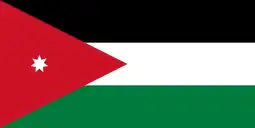 Jordan
Jordan Kuwait
Kuwait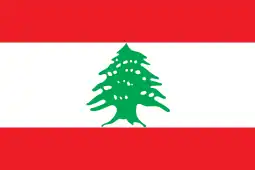 Lebanon – Had a special domestic variant of the OG-107 worn by the Lebanese Armed Forces and Internal Security Forces during the Lebanese Civil War; replaced by the U.S. Woodland Battle Dress Uniform (BDU) in 1983-84.
Lebanon – Had a special domestic variant of the OG-107 worn by the Lebanese Armed Forces and Internal Security Forces during the Lebanese Civil War; replaced by the U.S. Woodland Battle Dress Uniform (BDU) in 1983-84. Morocco
Morocco Nicaragua – Worn first by the National Guard of Nicaragua and after 1979 by the EPS.
Nicaragua – Worn first by the National Guard of Nicaragua and after 1979 by the EPS. Saudi Arabia
Saudi Arabia
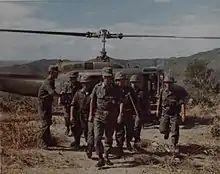
 South Korea - Had a special domestic HBT variant of the OG-107 worn during the Vietnam War.
South Korea - Had a special domestic HBT variant of the OG-107 worn during the Vietnam War. Syria
Syria Taiwan
Taiwan.svg.png.webp) Thailand – Formerly used by the Thai Armed Forces but now only used by Territorial Defense Students.
Thailand – Formerly used by the Thai Armed Forces but now only used by Territorial Defense Students. United States
United States Uruguay Uruguayan Air Force uniforms worn until the mid-90s when it was changed to the BDU.
Uruguay Uruguayan Air Force uniforms worn until the mid-90s when it was changed to the BDU.
References
- "Utilities/Jungle Fatigues". Moore Militaria. Retrieved June 21, 2023.
- Armies of the Vietnam War. Osprey Men at War. Vol. 1.
- Stanton 1998, p. 129.
- P. 14, Armies of the Iran–Iraq War 1980–88 (Elite), by Chris McNab and Stephen Walsh,Jan 18, 2022, ISBN 978-1472845573
Bibliography
- Stanton, Shelby L. (1998). U.S. Army Uniforms of the Cold War: 1948-1973. Stackpole Books.
Further reading
- Stanton, Shelby L. U.S. Army Uniforms of the Vietnam War.
- Miraldi, Paul. Uniforms and Equipment of U.S. Military Advisors in Vietnam: 1957–1972.
- Miraldi, Paul. Uniforms and Equipment of U.S. Army Infantry, LRRPS, and Rangers in Vietnam: 1965–1971.
- Lyles, Kevin. Vietnam: US Uniforms in Color Photographs.
- Lyles, Kevin. U.S. Airborne Vietnam.
- Armies of the Vietnam War. Osprey Men at War. Vol. 1.
- Armies of the Vietnam War. Osprey Men at War. Vol. 2.